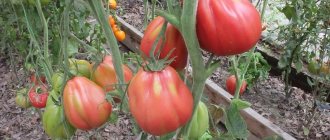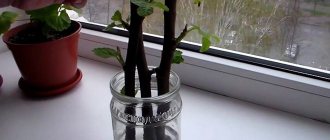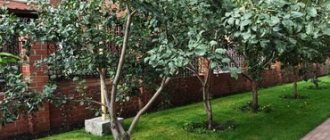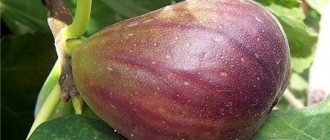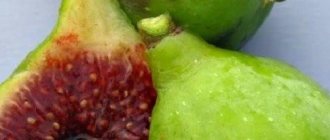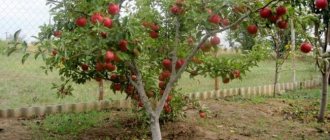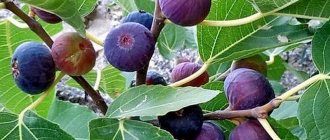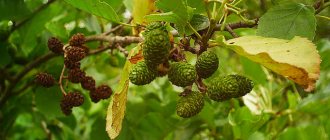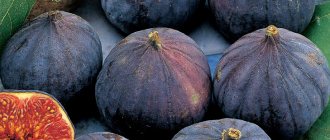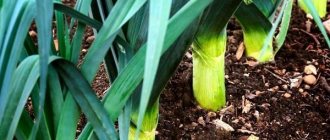Dalmatian (Die Dalmatie)
Obtained under this name from Georgia (Tbilisi Botanical Garden) in 1901, in 1932 again - from Italy under the name Fico Pionoto and Germany - Weisse Dama, as well as from Azerbaijan - Lagodekhi 1, Armud fig and from Georgia - Turkish white Described by Starnes and Monroy (1907) as Dalmatian, Dalmatia.
White Smyrna, D'Oree is not the variety we described, but close to the Brunswick variety. These authors write that the Dalmatian variety they describe is completely identical to the Magnolia variety. Condit considers the Brunswick and Magnolia varieties to be synonymous. The variety growing in the Nikitsky Garden called Dalmatsky is very close in description to the Datte variety (Condit, 1955; Starnes and Monroy, 1907) and to Datto 1 Tamaro, 1925) Condit gives synonyms for the Datte variety Fico Madama Rosso, Fico Rossete, Fico Datti etc. The brief description made by V.V. Markovich (1904) corresponds to the variety we are describing. However, A. S. Romanovsky (1902) reports that its fruits are purple. In Soviet literature, many authors describe it; these descriptions are identical, since they refer to one variety, transferred by the Nikitsky Garden in the form of cuttings and seedlings to 50 additional organizations of the USSR (Arendt, 1939, 1940, 1960; Chernenko, 1940; Fedorov, 1950; Nesterenko, Strebkova, 1949; Leontyeva and Manuylo, 1958, 1961). In 1950, it was included in state testing in the southern republics. Already in 1954, it was zoned in the Leninabad region, Vakhsh, Gissar and Kulyab zones of the Tajik SSR, in the coastal-Black Sea zone of the Krasnodar Territory and in the Transcaucasian humid zone of the Georgian SSR (Leontyeva and Manuylo, 1958).
Gives two harvests per year. The first one is July (in the southern Crimea) and is usually high - 1-3 fruits on an annual shoot. On trees 7-12 years old, the number of fruits ranged from 20 to 30-35 annually. The fruits of the second harvest are more numerous - 6-8 fruits on an annual shoot. However, their total number on the tree is less (800-1400) than that of other varieties, since Dalmatian forms very few branches, and in some years does not form them at all. According to the state variety plots, at the age of 8 years on the Adler variety plot it gave 56.4, on Lazarevsky at 7 years - 44, in the Uzbek SSR, on the Leninsky variety plot at 7 years - 31, Potiysky - 44.7, Lagodekhi (5 years) - 55 .5 kg.
In the conditions of southern Crimea it is self-fertile, but in dry years some of the inflorescences fall off without pollination. The absence of seeds impairs the quality of the fruit, and therefore the cultivation of this variety in the arid conditions of the USSR should be carried out together with pollinating varieties. The fruits are used mainly fresh. In Crimean conditions, they dry well and produce satisfactory dried products. According to Fedorov (1950), a high-quality dried product is obtained from Dalmatian fruits in Transcaucasia. They are also suitable for making candied fruits.
Fruit ripening in Crimea is early and more or less uniform (30-40 days). In the warmest years, the fruits of the first generation ripen in early July, the second - in August - September.
The trees are low, widely spreading, with wide flattened crowns and thin brown annual shoots. At the nodes and less often between them there are large and small round pink lentils. The apical buds are small, narrow, pinkish-olive. The inflorescences are large, especially of the first generation, elongated pear-shaped, asymmetrical, with a greatly expanded apex and a narrowed base, ribbed, with bright white and fine spotting. The eye is convex. The leaves are large, five-seven-lobed on long petioles, strongly incised, crenate at the edges. Their base is slightly heart-shaped, often cut off, the plate is thin, small, dark on top, stiffly pubescent. The lower leaves on the shoot are lowered down and fully open, the upper ones have edges curved inward.
The fruits of the first generation are very large (8-10X6cm) and heavy (150-180g), narrow pear-shaped, highly elongated, asymmetrical, with an influx at the short stalk, yellowish-green, pinkish at the top with translucent purple pulp. The skin is thin, with longitudinal cracks; The pulp is crimson, fine-grained, with very small seeds.
The fruits of the second generation are large (7.3X5.3 cm), up to 80-90 g each, light green, yellowish, with a very small closed eye and dense white spotting. The fruit is thin, white. The pulp is almost cavityless, dark crimson. Fruits without seeds have pink flesh.
Fresh fruits are juicy, sweet, with pleasant acidity. One of the best table varieties.
Source: FIG VARIETIES N.K. ARENDT
Early varieties
What are the ripening dates for figs? Like any fruit-bearing plant, it is divided into early, middle and late varieties; less often, the category of ultra-early ones is distinguished.
Brogiotto nero
| |
Dalmatian or Turkish white figs
| |
Brunswick figs
|
Figs: description, varieties, photos
The most popular ones include the following:
- Crimean black. It is of European origin. When caring for the crop, be sure to prune and shape the crown. Its high yield and mid-season fruit ripening make it possible to enjoy them twice a year - in July and September. The berries of the first harvest are large, purple, pear-shaped, asymmetrical in shape, weighing up to 80 g.
Frost-resistant
Figs, varieties of which can grow at temperatures down to -27 degrees, are grown in gardens and household plots as a decorative or fruit crop. Winter-hardy include:
- Brunswick. It is famous for its early ripening of very large fruits. Their weight reaches approximately 200 g. The shape of the berry is pear-shaped, the color is greenish with a purple tint. The juicy sugar pulp has wonderful taste qualities. Fruits twice a year. Multi-purpose application.
- Kadota. Medium-late ripening, harvested twice a year. The weight of the fruit of the first harvest is 70 g and 60 g of the second. The fruit is round in the shape of a pear, with a rather dense peel of a yellowish tint with a green tint. The rich, appetizing, pinkish-red flesh has an attractive taste. Figs of the Kadota variety are not damaged during transportation. Used in industrial and domestic conditions for the production of jams and preserves.
How and where to buy seedlings Fig Dolmatinsky
It is better to purchase Dalmatian fig seedlings from trusted nurseries. When purchasing seedlings, it is recommended to ask the seller whether the crop can bear fruit at home. Already rooted cuttings are considered the most reliable option.
Sometimes there is confusion with varieties, since some species are very similar to each other in their characteristics. It is better to immediately check with the seller whether he is selling the Dolmatinsky Fig. You should also read the reviews of those who have already purchased the culture.
So, Dolmatinsky Fig is valued for the fact that it is quite unpretentious and can be grown both at home and in open ground. However, in order for the plant to develop correctly and begin to bear fruit, it requires some care. The figs themselves are very tasty and are distinguished by the presence of a huge amount of useful substances.
Large-fruited
They have advantages over others due to their large and tasty fruits. The largest fruits include:
- San Pedro is black. It was bred in Spain and gained its popularity all over the world; the fruits are shaped like a beveled egg up to 10 cm in diameter, pleasant to the taste. The berries grow on vigorous fig trees that require care and good fertile soil. Under ideal conditions, the fig tree produces a rich harvest twice a year. The fruits have aromatic, sweet pink flesh and almost black skin. Consumed fresh, dried or processed.
- Corderia. The berries of this variety of figs (photo below) are large, covered with a yellowish-green skin and contain orange, very sweet pulp of excellent taste.
Fig care
Watering will depend on the age of the tree. Young growth should be watered weekly, adding 5 to 10 liters of water under the tree. The next season, when the root system is formed, the tree needs to be watered once every two weeks, adding about 10 liters of water under it. When the fruits ripen, it is not advisable to water the fig tree. The last watering is carried out in mid-autumn to increase the frost resistance of the crop. After moistening the soil, it is necessary to loosen it and remove weeds.
The tree should be fertilized at least once or twice a month. At the beginning of the growing season, it is necessary to use nitrogen fertilizers. In mid-summer, phosphates will be required as they promote fruit set. At the end of the growing season, potassium fertilizers should be applied. They will allow the figs to ripen better and faster. Every month the tree must be fed with microelements and fertilizers to help it develop normally.
It is advisable to carry out root feeding every month by spraying the figs with a nutrient solution. Organic feeding is also important for the fig tree, in the form of humic acid, microorganisms and soil. Fertilizing should be done only after watering to avoid burns to the roots.
Pink fig tree
The fig variety Sabrucia rosea bears fruit without pollination, is a winter-hardy tree, can withstand frosts down to -18 degrees, and produces two harvests per season. The first is called winter because the ovary forms in the fall and, with good shelter, is perfectly preserved until the spring warmth. In July these fruits ripen. And at the very beginning of June, in place of the new growth, a second harvest is formed, the fruits of which ripen in September.
Figs: description and reviews
Varieties that are relatively resistant to frost include:
- Sochi 7. Good yield, fruit weight reaches 50 g, the berries have a pleasant, slightly sour taste.
- Nikitsky. The plant is partially self-fertile, mid-ripening, the fruits are sweet and sour, large.
- Dalmatian. One of the best table varieties (description above).
- plant the plant in places protected from the wind and form it correctly;
- before the onset of winter, the soil in the root part of the plant should be dry, and the roots themselves should be moist;
- Make the shelter breathable so that fungal diseases do not appear, and during thaws there is ventilation.
Brunswick figs are the most frost-resistant
This variety is also called Chapla or Buzoi Burnu. Refers to self-fertile. The first harvest produces a small number of fruits. But they are large, reaching two hundred grams. The second harvest pleases with a large number of smaller figs. The fruits are light green in color with a raspberry core. The variety has proven itself to have excellent taste and frost resistance down to -28°C.
Brunswick figs are popular all over the world.
Sometimes in markets and fruit shops you may be offered to buy royal figs. There is no variety as such in the register. Most often, this is the name for large-sized fruits with a dark blue or purple peel color. This name is not evidence of the variety, but an indicator of quality.
Video: Brunswick figs
Figs are one of the most ancient fruit crops on Earth, and in our latitudes they are more often found in winter gardens or grown as a houseplant. Many gardeners are stopped by the fact that the tree needs winter shelter, as it does not tolerate frost. But, after studying the descriptions and choosing the optimal frost-resistant fig varieties for yourself, taking care of the correct agricultural technology and protecting the plant from the cold, you will forever remain a fan of this culture.
Rate this article:
[Votes: 2 Average: 5]
Growing figs in the garden
Figs are native to the Mediterranean countries and other countries with mild climates. We, residents of central and eastern Ukraine, are also not averse to getting involved in the cultivation of exotic fruits, but the question immediately arises: how will heat-loving figs survive our cold winters? Is it possible to grow it in the garden and how to do it? As the experience of Ukrainian gardeners proves, with desire and hard work this is quite possible.
Figs (or fig trees, or figs) are one of the most ancient plants cultivated by humans. The Latin name "Ficus carica" indicates to us that the fig belongs to the genus Ficus. We find mention of it in the Bible. After all, it was with a leaf of this tree that Adam and Eve covered their nakedness after eating the fruit of the tree of knowledge. An unpretentious plant with beautiful large leaves attracted people's attention with its fruits, sweet as honey. Tasty and tender, they are at the same time very nutritious and healthy, and can quickly fill you up.
As mentioned above, many Ukrainian gardeners living in Kyiv, Dnepropetrovsk, Kharkov and other regions have experience growing this plant in open ground. We will talk about the features of agricultural technology for the regions of Ukraine in the article.
In its native habitat, figs grow as a fairly large tree, but in our country they are grown as bushes.
figs in a cordon mold
bush-shaped fig
Growing methods
In its native habitat, figs grow as a fairly large tree, but in our country they are grown as bushes. The main secret to successfully growing figs is to provide them with conditions for successful wintering. To do this, as a rule, it is grown in holes or trenches, which is convenient for winter shelter for a heat-loving plant.
Two main ways:
1. Growing at an angle of 45°. The seedling is positioned in such a way when planting to make it easier to bend down the branches before covering them.
2. Formation of a horizontal cordon. In this case, the seedling is planted vertically, the top is cut off, and the growing side shoots are carefully bent to the ground. They are arranged in the form of sleeves directed along one line in opposite directions. From the buds on these shoots, vertically growing branches develop, on which the crop will ripen.
Planting a seedling
First, choose the warmest place in the garden, protected from the wind, and prepare a hole. You need to dig a trench if you are going to plant several plants at once. This must be done in advance, as the process is quite labor-intensive.
To plant one plant, dig a hole about 1.5 m long, 1 m wide and 60–80 cm deep. A deep hole for planting the seedling itself is not needed, since the fig root system is superficial.
For convenience, you can plant 2 plants at once, then increase the length of the trench to 2 m. Place the seedlings at opposite ends at an angle to the center of the trench. It is convenient to bend the shoots growing towards each other and make a common shelter for the winter. This arrangement also saves space and labor costs.
Fold the top fertile layer of soil separately to later fill it into the planting hole. When the hole is prepared, pour 1.5 buckets of humus or compost, 200 g of superphosphate, 200 g of potassium fertilizers (wood ash can be used) onto the bottom, then a layer of prepared fertile soil.
Form a small mound in the hole, spread the roots of the seedling on it, cover it with soil, compact it and water it generously. As for fertilizers, you don’t need to use them, because in nature, figs grow even on poor rocky soils. Therefore, you can add sand and small stones to the soil mixture.
Figs are planted in open ground at the end of April - beginning of May, when the threat of night frosts has finally passed. When growing a large number of plants, the trench should be located in the direction from east to west, so that the sun's illumination is maximum.
Figs are planted in open ground at the end of April - beginning of May, when the threat of night frosts has finally passed.
sweet figs
Care and shaping
After planting, the seedlings must be watered frequently and abundantly at first, then a couple of times a month. Maintain the height of the bush by pruning no higher than 2 m. Pay special attention to pruning and crown formation. The crown needs to be thinned out so that the fruits are well illuminated by the sun and ripen.
How figs overwinter
In the autumn, after leaf fall, at the end of October - beginning of November, fig bushes growing at an angle can be gradually and carefully bent to the ground, trying not to break off the branches. Then tie them up and sprinkle them with soil, dry leaves and other plant debris. With the onset of frost, cover with two layers of black spunbond, and after a while with plastic wrap. Some gardeners build a low frame shelter made of polyethylene over the bushes. This is optional.
In the spring, with the onset of above-zero temperatures, the shelter can gradually be removed. It is completely removed when stable warm weather sets in without the threat of return frosts. Every year the branches become thicker, and it is difficult to bend them, so such branches just need to be cut out.
When can we expect the harvest?
Figs are a fast-growing crop and begin to bear fruit already in the second year after planting. In nature, figs are a dioecious plant, i.e. there are male and female trees. The pollination process is very complex, the main role in it is played by the blastophagous wasp, which carries pollen, pollinating plants. Since this wasp does not live everywhere, breeders have developed self-fertile - parthenocarpic varieties. These are the varieties that are usually used in cultivation. This allows you to get a harvest even when growing one bush.
You cannot see a flower in the form we are used to in a fig. It seems that a small fruit is immediately formed, which grows and ripens. In fact, the fig flower develops in the axils of the leaves inside spherical thickened shoots with a hole at the top. The flowers are small and inconspicuous. Female infructescences - figs - as they ripen, acquire rather large pear-shaped shapes.
Most varieties produce two harvests per year: the first in early summer on last year's shoots, and the second in September - October on current shoots. In our conditions, when growing in open ground, you need to focus on getting fruit in the fall. But when growing figs in a greenhouse, you can get two harvests in a year. The moment of fruit ripeness is determined by the color of the skin and its density. The ripe fruit has a color characteristic of the variety (green, brown, yellow or dark purple) and is soft to the touch.
Reproduction. Figs are easy to propagate using cuttings in the fall during pruning or in early spring. Cuttings harvested in the fall are stored in the basement until mid-January. Then they are germinated like grape cuttings.
The most popular varieties of figs
05/02/2018 Figs are a very ancient fruit crop, which, according to scientists, has been giving wonderful fruits to humanity for more than five thousand years. This plant is mentioned several times in the Old and New Testaments, and according to one legend, it grew in the Garden of Eden. In addition, figs have been considered a symbol of prosperity, peace and eternal life for many centuries.
It is noteworthy that fig fruits are essentially the inflorescence of a tree of the genus ( lat. ficus carica
).
The culture has several names: Carian ficus, fig tree, fig tree, fig tree, mulberry ficus. Today, more than one thousand (!) different varieties of figs are known, which differ in color and fruit size, yield, taste characteristics, duration of the growing season and, accordingly, different ripening periods. Breeders have also developed varieties of plants that are practically not eaten fresh, but are entirely used for the preparation of dried fruits.
There are also varieties of figs that do not require insect pollination, but are still capable of producing multiple harvests throughout the year, as well as frost- and drought-resistant plants. Therefore, before buying a seedling, it is advisable to first read the description of its characteristics in order to be sure that the chosen variety is suitable for both the climatic conditions and the characteristics of the area in which it will grow.
You can grow figs yourself (from seeds). A tree planted from seed usually begins to bear fruit in its seventh or eighth year. However, plants grown in this way usually have a weak root system and a rather thin trunk. Grafted trees begin to bear fruit much earlier, so you can enjoy figs already in the fourth year. At the same time, the base of the trunk and the root system are more powerful, and the branches at the base are thicker and stronger.
The most common varieties of figs:
· "Crimean Black"
This variety of fig was grown by biologists of the Nikitsky Botanical Garden. This is a fairly early variety, producing two harvests per year, and does not require pollinating insects.
The fruits of the “Crimean Black” variety are quite large (up to 80 grams), have a round, pear-shaped shape with ribs around the perimeter and a dark, purple (almost black) color. Inside the fruit is very juicy, dark raspberry-red in color. The skin is thin, and the flesh is sweet, with a slight pleasant dessert sourness.
This variety is suitable for both home preparation and drying. The first harvest is usually harvested in August, and the second in September.
It should be remembered that this variety of fig is very sensitive to pruning, therefore, with the correct and timely formation of the crown, it consistently demonstrates a good harvest.
· "Gray early"
Early variety. Gives two harvests. The fruits are round in shape and medium in size (about 40 grams). The skin color is usually light brown or purple, and the flesh inside is very juicy and extremely tasty.
"Dalmatian" or "Turkish white"
This fig variety is rightfully considered one of the best early table varieties. Self-pollinates. It produces two harvests per year, and the fruits are quite large (up to 180 grams).
It is noteworthy that this variety can withstand temperatures down to minus 15°C.
The fruits are pear-shaped with greenish skin. Inside the pulp has a reddish tint. Very juicy and sweet in taste.
· "Randino"
This fig variety produces two abundant harvests per year. The fruits have a slightly oval ribbed shape and a very large size (up to 100 grams). The skin color is olive. The pulp is juicy and sweet. Suitable for both fresh consumption and homemade preparations and compote.
· “Abkhazian purple”
The ripening period is medium-late. Gives two harvests.
The fruits have a slightly elongated shape with protruding ribs, weigh up to 80 grams and have the highest taste characteristics.
· "Kadota"
Frost-resistant variety. Withstands temperatures down to minus 10°C (!).
Developed in the United States, where it is very popular. Medium-late period of fruit ripening. Self-pollinates. It should be grown on the sunny side of the site and covered for the winter.
The fruits are not very large in size (up to 70 grams), rounded pear-shaped with dense and light greenish skin. The pinkish flesh has a surprisingly juicy and sweet taste.
This variety of figs is well stored and can withstand long-term transportation. The fruits tend to wilt directly on the tree and are well suited for homemade preparations and compotes.
Brunswick
The variety is frost-resistant, so it can be grown as a fruit garden crop and as an ornamental crop. Withstands temperatures down to minus 27°C (!).
Early variety. It has very large (up to 200 grams) fruits. Self-pollinates. Fruits twice in one season.
The shape of the fruit is pear-shaped, with a light greenish tint and a purple side. The sweet and juicy raspberry-colored pulp has high taste characteristics, so it is consumed both fresh and dried. Well suited for home preparations.
Useful properties of figs
Among all types of dried fruits, figs firmly hold first place in fiber content. In addition, the fruits contain a large amount of vitamins, macro and microelements. Includes a large number of natural sugars.
The high potassium content has a positive effect not only on the functioning of the heart muscle, but also on the entire cardiovascular system. Figs also normalize the activity of the liver, kidneys, and gastrointestinal tract.
As it turned out, fig fruits have a paralyzing effect on cancer cells and promote rapid regeneration of the retina, therefore they are recommended for people suffering from diabetes, as well as patients with metabolic disorders and people suffering from obesity.
Growing in Ukraine
In cold regions, it is advisable to grow figs in greenhouses or carefully wrap the plant with the onset of winter cold. Under moderate climatic conditions, this crop can be planted in open ground (on the sunny side), but it is advisable to provide protection from the influence of winds.
The beneficial properties of figs, as well as its high taste, deserve to be given special attention to this plant.

